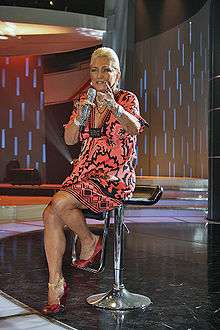Hebe Camargo
| Hebe Camargo | |
|---|---|
 Hebe Camargo | |
| Born |
Hebe Maria Monteiro de Camargo March 8, 1929 Taubaté, São Paulo, Brazil |
| Died |
September 29, 2012 (aged 83) São Paulo, São Paulo, Brazil |
| Other names | Rainha da TV Brasileira ("Brazilian TV queen"), Loiruda |
| Occupation | Presenter, actress, singer. |
| Years active | 1943–2012 |
| Height | 1.60 m (5 ft 3 in) |
| Weight | 63 kg (139 lb; 9.9 st) |
| Spouse(s) |
Décio Capuano (m. 1964–71)(divorced) 1 child Lélio Ravagnani (m. 1973–2000)(his death) |
| Website | Official website |
Hebe Maria Monteiro de Camargo Ravagnani DmSE • Dama Oficial • DmIH [1](Portuguese pronunciation: [ˈɛbɪ mɐˈɾi.ɐ mõˈteɪ̯ɾʊ dʒɪ kɐˈmaɾɡʊ ˈʁavɐˌɲɐ̃ni], March 8, 1929 – September 29, 2012) was a Brazilian television host, singer and actress. She is considered the "Queen of Brazilian Television". She died at her home on September 29, 2012. Her net worth was over US$360 million.[2]
Early years
Hebe Camargo was born in Taubaté, São Paulo, on March 8, 1929.[3] She began her career as a singer in the 1940s with her sister Estela, as Rosalinda e Florisbela. During her singing career, Camargo performed sambas and boleros in nightclubs.[4] She left her musical career to devote more time to radio and television.[3] She was invited by Assis Chateaubriand to attend the first live broadcast of Brazilian television, in the neighborhood of Sumaré, São Paulo, Brazil.[4]
Career
As a singer, Camargo appeared in comedy films by Mazzaropi and starred with Agnaldo Rayol in one of them.[3] In the 1950s, she entered television and worked as a presenter in a series on TV Paulista. In 1955, Camargo appeared in the first program for women on Brazilian television, O Mundo é das Mulheres (The World belongs to Women), on television in Rio de Janeiro,[5] which aired five times a week.
In the 1960s, Camargo moved to the Rede Record network, where, for many years, she maintained a top-rated program. During the Jovem Guarda era, Hebe gave way to new talent. On April 10, 1966 the network began broadcasting a Sunday program featuring Camargo as an interviewer.[6][7]
Camargo has been seen on almost every television station in Brazil, including the Rede Record and Rede Bandeirantes, in the 1970s and 1980s.[8]
In 1980, after a long hiatus she returned to work as an interviewer. From March 1986 to December 2010, Camargo was on the SBT Network, where she presented the television program Hebe, which became one of the network's longest-running programs. The show was also broadcast on Rede Tupi and Rede Bandeirantes, and had a spin-off show Hebe por Elas (Hebe for All) in the early 1990s.[9] She also presented Fora do Ar, and participated in Telethon, comedy specials, and Romeu e Julieta, in which she starred with Ronald Golias and Nair Bello.[10]
In 1995, EMI released a CD of Camargo's greatest hits. On April 22, 2006 she celebrated her thousandth program on SBT. She also has participated in social activities, such as taking part in the Cansei movement, a 2007 protest critical of the Brazilian government.[11]
Camargo was spending New Year's Eve in Miami when she complained of severe abdominal pain. A bulletin issued by the hospital later reported that Hebe was subjected to a diagnostic laparoscopy, which found cancer.[12][13] On January 8, 2010, Camargo was admitted to Albert Einstein Hospital in São Paulo[14] for surgery to remove cancer from the peritoneum.[15] After surgery and chemotherapy, she returned to work on March 8, 2010.[16]
On April 28, 2010, Camargo underwent a clinical examination at the Albert Einstein Hospital in São Paulo. The exam found that the cancer discovered in January was gone, and no more treatment was needed.[17] God never left me, never saw life with so much joy", she said to thank her fans for their support.[18]
Illness and death
Camargo suffered from cancer since 2010. She died at dawn on September 29, 2012, having probably suffered a cardiac arrest while she was sleeping.
Awards and honors
- 1990 — "The face of São Paulo"
- 1994 — "Citizen Paulistana" from the Câmara Municipal
- 2002 — "Tribute in Portugal"
- 2007 — "Special Award", for Prêmio Contigo!
- 2009 — "Title of Professor Honoris Causa" of the Universidade FIAM-FAAM
- 2010 — "Award LIDE 2010" of the Comitê Executivo do Grupo de Líderes Empresariais
- 2010 — "Latin Grammy Awards- Trustees Award" [19]
- "Best Interview" of the Associação Paulista dos Críticos de Artes
- "Best auditorium program presenter" of the Brazilian Academy of Letters
Filmography
- 2009 - Xuxa e o Mistério de Feiurinha
- 2005 - Coisa de Mulher (Chick Thing)
- 2000 - Dinosaur (Portuguese dubbing of Baylene)
- 1960 - Zé do Periquito
- 1951 - Liana, a Pecadora
- 1949 - Quase no Céu
Television career

- 2010 - Fantástico
- 2010 - SBT Brasil
- 2009 - Elas Cantam Roberto
- 2009 - Vende-se Um Véu de Noiva
- 2007 - Amigas e Rivais
- 2003 - Romeu e Julieta Versão 3
- 2000 - TV Ano 50
- 1995 - A Escolinha do Golias
- 1990 - Romeu e Julieta Versão 2
- 1980 - Cavalo Amarelo
- 1978 - O Profeta
- 1970 - As Pupilas do Senhor Reitor
- 1968 - Romeu e Julieta Versão 1
- 1950 - Primeira Apresentação Musical da TV Brasileira
Discography
- Hebe e Vocês (1959)
- Festa de Ritmos (1961)
- Hebe Camargo (1966)
- Maiores Sucessos (1995)
- Pra Você (1998)
- Como É Grande o Meu Amor Por Vocês (2001)
- As Mais Gostosas Da Hebe (2007)
- Hebe Mulher e Amigos (2010)
See also
References
- ↑ A EXALTAÇÃO DE HEBE CAMARGO EM GALA NO PORTO
- ↑ Veja quem vai ficar com a fortuna de Hebe Camargo
- 1 2 3 "Biografia de Hebe Camargo". Portal São Francisco. January 16, 2010. Retrieved January 16, 2010.
- 1 2 "Perfil de Hebe Camargo no Te Contei".
- ↑ "BOL, Hebe Camargo completa 80 anos neste domingo".
- ↑ DELAS Web Radio :: Porque o mundo é Delas!
- ↑ Dramaturgia Brasileira - Hebe Camargo
- ↑ "Hebe Camargo - A Rainha da TV". oglobo.globo.com. January 17, 2010. Retrieved January 17, 2010.
- ↑ "OFuxico - Hebe Camargo faz 80 anos e ganha homenagem". Archived from the original on February 20, 2009.
- ↑ Especial Hebe Camargo, NO AR! "CTN:. Canal News Audiência da TV
- ↑ Rocha, Thiago (August 17, 2007). "Hebe e Ivete Sangalo engrossam a multidão do 'Cansei'". OFuxico. Archived from the original on February 8, 2009. Retrieved August 16, 2011.
- ↑ Hebe Camargo passa bem após cirurgia de três horas - Folha Online
- ↑ Hebe Camargo está com tumor no peritônio, informa boletim médico - Folha Online
- ↑ News "Hebe Camargo was admitted in São Paulo" - Hebe Camargo
- ↑ Hebe Camargo está internada em São Paulo e deve ser operada - Folha Online
- ↑ "Hebe Camargo Says She is 'Bald', Just Like Marcelo Tas". diversao.terra.com.br. March 24, 2010. Retrieved April 16, 2010.
- ↑ "Empresários e assessores garantem que Hebe está curada do câncer".
- ↑ "Exame indica que Hebe Camargo está livre de câncer".
- ↑ http://www.latingrammy.com/en/content/special-awards
External links
- Official website
- Hebe Camargo at the Internet Movie Database
- Site of Hebe program at RedeTV!
- Hebe Camargo facts on Freebase
- Hebe Camargo - Biography, Photo Gallery, Latest News, Message board
- Hebe Camargo latest news and videos